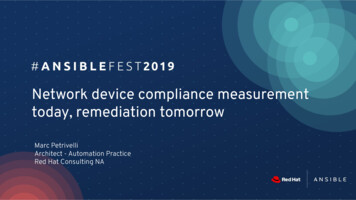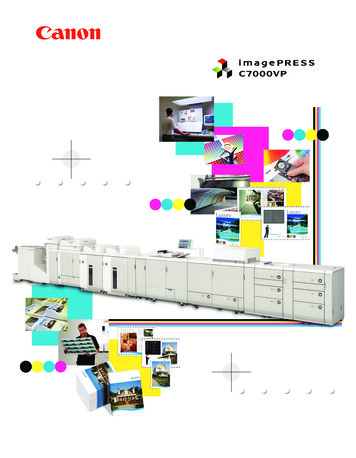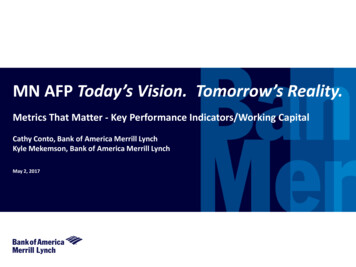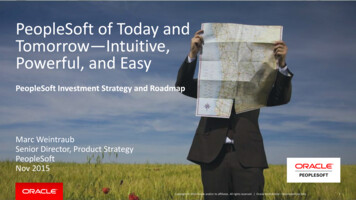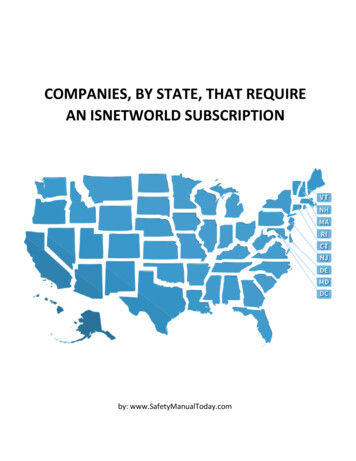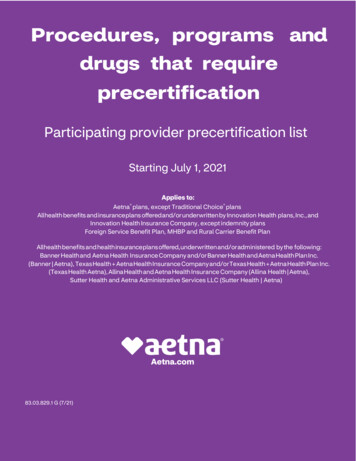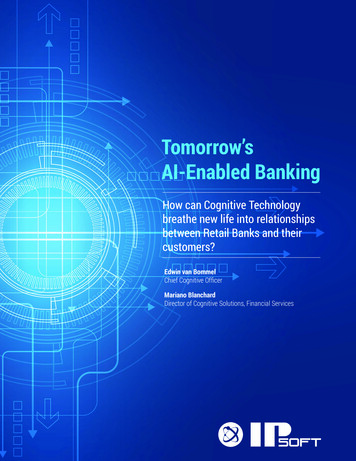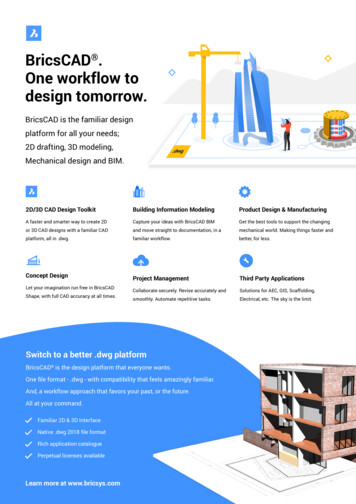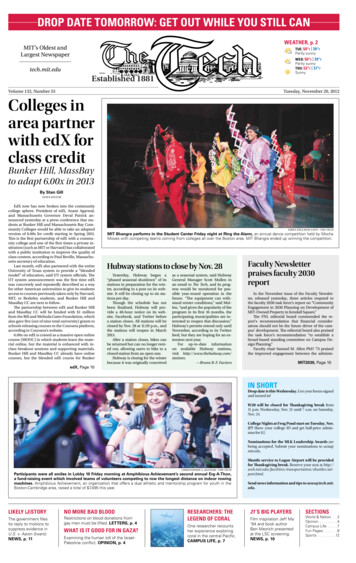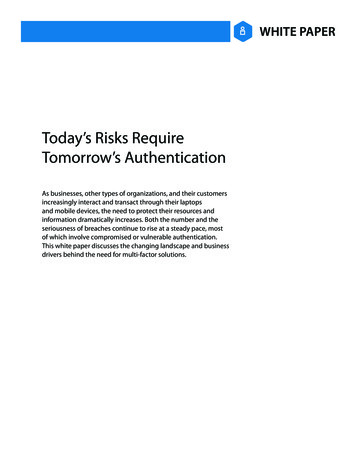
Transcription
Today’s Risks RequireTomorrow’s AuthenticationAs businesses, other types of organizations, and their customersincreasingly interact and transact through their laptopsand mobile devices, the need to protect their resources andinformation dramatically increases. Both the number and theseriousness of breaches continue to rise at a steady pace, mostof which involve compromised or vulnerable authentication.This white paper discusses the changing landscape and businessdrivers behind the need for multi-factor solutions.
WHITE PAPERTable of ContentsResponding to Today’s Security Threats . . . . . . . . . . . . . . . . . . . . . . . . . . . . . . . . . . . . . . . . . . . . . . . . . . . . . . . . . . . . . . . . . . . . . . .1Today’s Breach Trend is Clear. . . . . . . . . . . . . . . . . . . . . . . . . . . . . . . . . . . . . . . . . . . . . . . . . . . . . . . . . . . . . . . . . . . . . . . . . . . . . . . . . 2Working within Regulated Industries . . . . . . . . . . . . . . . . . . . . . . . . . . . . . . . . . . . . . . . . . . . . . . . . . . . . . . . . . . . . . . . . . . . . . . . . . 3Healthcare. . . . . . . . . . . . . . . . . . . . . . . . . . . . . . . . . . . . . . . . . . . . . . . . . . . . . . . . . . . . . . . . . . . . . . . . . . . . . . . . . . . . . . . . . . . . . . . .3Financial. . . . . . . . . . . . . . . . . . . . . . . . . . . . . . . . . . . . . . . . . . . . . . . . . . . . . . . . . . . . . . . . . . . . . . . . . . . . . . . . . . . . . . . . . . . . . . . . . . 3Federal. . . . . . . . . . . . . . . . . . . . . . . . . . . . . . . . . . . . . . . . . . . . . . . . . . . . . . . . . . . . . . . . . . . . . . . . . . . . . . . . . . . . . . . . . . . . . . . . . . . 4State and Local Organizations . . . . . . . . . . . . . . . . . . . . . . . . . . . . . . . . . . . . . . . . . . . . . . . . . . . . . . . . . . . . . . . . . . . . . . . . . . . . .4The Evolution of Secure Access . . . . . . . . . . . . . . . . . . . . . . . . . . . . . . . . . . . . . . . . . . . . . . . . . . . . . . . . . . . . . . . . . . . . . . . . . . . . . . .4Moving Forward. . . . . . . . . . . . . . . . . . . . . . . . . . . . . . . . . . . . . . . . . . . . . . . . . . . . . . . . . . . . . . . . . . . . . . . . . . . . . . . . . . . . . . . . . . . . . 5NetIQ Advanced Authentication Framework—for today and tomorrow. . . . . . . . . . . . . . . . . . . . . . . . . . . . . . . . . . . . . . . . 6About NetIQ. . . . . . . . . . . . . . . . . . . . . . . . . . . . . . . . . . . . . . . . . . . . . . . . . . . . . . . . . . . . . . . . . . . . . . . . . . . . . . . . . . . . . . . . . . . . . . . . . 7WHITE PAPER: Today’s Risks Require Tomorrow’s Authentication
Responding to Today’s Security ThreatsThe transformation of how people work and play continues to evolve towards a mobile lifestyle where people don’tneed to be in the office to work or at the store to shop. In fact, according to IDC , 1.3 billion of today’s workforce ismobile. In other words, one third of today’s workforce works outside of the office.For many professionals, the ability to stay connected using phones and the Internet enables them to accomplishtasks, collaborate with colleagues and specialized teams, and conduct most types of business interactions. However,these same trends create points of vulnerability for unseen criminals. The internet provides the connectivity andinterconnected social media platforms that result in an expansive attack surface for criminals to circumvent traditionalauthentication and access protections .As the continual stream of headlines shows, this new paradigm of engaging with applications and services beyondthe corporate firewall changes the rules for how organizations manage risk and apply security. The ramifications ofbreaches are real and sometimes very damaging. In addition to the immediate financial cost that breaches incur,frequently customer trust is lost, brand reputation is tarnished, and, in instances where regulated industries areinvolved, privacy rules are violated, creating additional costs and potential fines.NetIQ believes traditional, single-factor authentication, including username and password, is no longer a sufficientapproach to protecting corporate, employee or client information. And as a result of the increasingly sophisticatedattacks being levied at users and organizations, the paradigm of protecting against unauthorized access must alsoevolve. Users and their devices are continuously connected and exposed to a variety of attacks. Even when users areworking from inside an organization’s facilities, many of the services they access no longer reside inside their firewall’sperimeter, but rather out in the cloud, allowing ubiquitous access for all, both friend and foe. Moreover, since criminalsand conspirators have gotten quite good at duping people into divulging theircredentials (what they know), an effective way to increase security is to leveragewhat they have (such as a FIDO U2F device) or what they are (such as abiometric reader). The use of these various authentication methodsis called multi-factor authentication (MFA).If done right, combining two or more authentication methodsmakes it exponentially more difficult for the bad guys to circumventaccess policies, reducing the risk to the organization. This paperdiscusses the changing trends of how professionals inadvertentlycreate risk to the organization as they do their jobs and blendtheir professional and personal lives by consuming and sharinginformation. It is intended for individuals who are researching andgathering information in preparation of a proposal or business case forenhancing an organization’s authentication. This information providesa foundation from which an organization can move beyond passwords andupgrade the authentication experience to a level that increases the security whilemaintaining or improving user ays/WHITE PAPER: The Importance of Choosing the Right Workload Migration Tools 1
Today’s Breach Trend is ClearThe job of managing against risks associated with the use of traditional credentials continues to elude ITadministrators. In fact, it is more difficult than ever before because users connect to both personal and corporateservices with the same device, which is often personal. If given the opportunity, many users would simplify lifefor themselves by using weak passwords or writing them down. And even if policies exist to protect against userswho would otherwise rely on simple passwords, security can still be susceptible to social engineering, intentionalor otherwise. Users that blend their personal (and often less secure) credentials with those used to protect privatecorporate or customer information introduce one of today’s most challenging risks. This expands the attack surfacewhere if one instance of the user’s credentials is compromised, it also risks exposing corporate services. Unfortunately,as seen frequently in the press, months usually go by before victimized institutions realize the breach and alert thepublic. Regardless of the password policy implemented, if a user reuses a password across his or her professional andpersonal (social) services, the risk of a breach escalates. Each security team needs to have a plan in place that managesthe vulnerability of reused credentials across multiple cloud-based systems.For environments where employees move from station to station or room to room, the pressure to share credentialsincreases. Credential sharing can be convenient and highly efficient and is especially prevalent in industries such asmanufacturing, defense contracting and healthcare. These shortcuts may save users time, but this is at the expenseof security. While healthcare clinicians often fall into this practice in environments where they move from patient topatient and are pressed to optimize their time, this type of situation can be found throughout many organizations—from call centers, banks and retailers, where customer information may be at risk, to government agencies and theircontractors where all types of secured information are at risk.Although unseen criminals continue to raise the level of sophistication in their attacks, a report jointly issued byForrester and Trend Micro notes that threats more frequently come from someone inside the organization. In fact,70 percent of the time, unauthorized access comes from someone within the organization, or a contractor workingwithin the secure perimeter . Although IT organizations may think first of theiremployees, several high-profile intrusions highlight and reinforce theproblem of contractors sharing their credentials. Since contractorsare often in transition, this tends to be a more frequent problem.It’s not unheard of for contractors to focus on their specificproject with the here-and-now attitude at the expense of thesecurity of an employer or customer with whom they don’thave a long term relationship. But whether it’s an employee,contractor or partner, the workforce’s ability to share accountsis shortsighted and subjects the company to undue risk.In their recent threat report, McAfee Labs describes a million new phishing sites created duringthis past year. The report highlights not only the rapid growth of active sites, but also an increasein their sophistication . Widely available digital content about potential victims’ interests, activities andwhere they work makes it easier for phishermen to learn about and more effectively attack their targets. Whether it ults-taking-online-password-security-risks/34WHITE PAPER: The Importance of Choosing the Right Workload Migration Tools 2
an email claiming to be from a friend, organization, work, or some other party with whom that person interacts, theseemails and websites look authentic enough for unfortunate users to make that click that enables a keylogger to bedownloaded or invites them to divulge their credentials.User education against phishing is the single most effective step an organization can take against these kinds ofattacks. Antivirus and malware protection are the basic steps that every organization should take, but upgrading toan MFA for valued information is equally important and should be included in the majority of organizations’ defenseplans. Advanced authentication technologies can be used for out-of-band identity validation to protect compromisedaccounts and man-in-the-middle vulnerabilities. When implemented correctly, it will significantly increase security forvirtually all environments.In today’s universally connected digital world, how much risk should an organization be willing to take? Whether itbe through users implementing common credentials across their work and home environments or account sharing,betting on a single point of credential protection failure is becoming more foolish as attack mechanisms continue toincrease in sophistication. Even for organizations that have strict password complexity policies, their value is limitedwhen they are reused repeatedly on other websites. Recent studies show that more than half (55%) of adult internetusers admitted that they use the same password for most, if not all, of their websites . As the consumption of cloudbased applications continues to proliferate, the chance of compromised credentials draws nearer to inevitable.Working within Regulated IndustriesWhile each organization is free to choose the level of risk they are willing to take, they don’t have the prerogative tochoose which regulations they will follow. Each year, regulators set more specific security requirements and audit moreaggressively. And as the number of access breaches continues to rise, this trend is likely to continue.HealthcareRegulators significantly changed the Health Insurance Portability and Accountability Act (HIPAA) in the lastseveral years. Privacy rules continue to become more encompassing and detailed. There is a greater liability forthose who fail to implement technologies enabling compliance to HIPAA and Health Information Technologyfor Economic and Clinical Health (HITECH) rules. For example, specific consequences and accountability forviolations and breaches are now in place. And if unauthorized access of regulated patient records occurs,organizations must notify the department of Health and Human Services and their patients of the breach. Ifthe breach was the result of the organization not following HIPAA or HITECH rules, regulators now require adetailed plan of how the organization will become compliant, as well as the timeline for doing so.As organizations strive to meet compliance, the Office for Civil Rights (OCR) continues to find ways to be moreeffective in their auditing programs. To accomplish this, they work with auditing firms as well as the healthcareagencies themselves to implement a combination of self-auditing and health checks.FinancialFederal agencies responsible for the compliance of financial and insurance institutions established rules,guidelines and audit procedures to ensure regulated organizations aggressively manage risk. A highlevel of security is a foundational component for making transactions as secure as possible. The FederalFinancial Institution Examination Council (FFIEC) published rules for implementing proper authenticationWHITE PAPER: The Importance of Choosing the Right Workload Migration Tools 3
methodologies to match the level of risk involved in the transaction. FFIEC instructs IT organizations to takea risk-based layer of security approach in their implementation and have the ability to perform reviews ofan institution. Because of these strict rules surrounding access, advanced authentication is a fundamentalrequirement to whatever access environment a financial institution offers.FederalIT security managers in federal agencies face increasingly complex challenges as they try to keep up withtheir access control requirement. These agencies commonly have unintegrated silos of authenticationenvironments, each requiring their own point of administration. In addition, most of these deploymentslocked the federal agencies into specific brands and types of authentication solutions. The National Instituteof Standards and Technology (NIST) issued additional publications providing concrete guidance for theseFederal Information Security Management Act (FISMA) mandates. They provide guidance on access controlsand permission management, both of which should be based on strong authentication. In other words,performing certain actions or accessing specific information requires some type of advanced authenticationmethod.State and Local OrganizationsVirtually all state and local agencies rely on federal databases for information on people of interest. To gainaccess to these databases and records, agencies must comply with government access and authenticationrequirements. The Criminal Justice Information Services (CJIS) defines and enforces policies to ensure that theirinformation (CJI) remains secure and protected from unauthorized access. These policies include requirementsfor the creation, viewing, modification, transmission, dissemination, storage and destruction of CJI data. Afairly recent change in this policy is the requirement for the use of advanced authentication methods whenaccessing this information outside of a federally approved (secure) building. As a result, this mandate affects allpersonnel accessing CJI from their homes or squad cars.The latest mandate has the potential to make CJI access quite difficult for state and city agencies. They oftenhave one or more building-access infrastructures in place, but they are seldom integrated and require multipletouch administration. For many agencies, this mandate will result in yet another authentication solutionand additional point of administration. However, NetIQ Advanced Authentication Framework handles mostauthentication methods and provides a single set of policies and point of administration. NetIQ AdvancedAuthentication Framework not only ensures authentication compliance, but also equips organizations withwhat they need to adopt different or newer authentication technology in the future, without deployinganother instance of infrastructure.The Evolution of Secure AccessWhile security is and should be the fundamental requirement when deciding on anauthentication solution, convenience is just as important. In fact, the ultimate measureof success of an authentication process is how effectively the business keeps itsinformation secure while preserving the ease of accessibility over time. If users abstain orprocrastinate completing tasks or business processes because authentication and accessWHITE PAPER: The Importance of Choosing the Right Workload Migration Tools 4
is cumbersome, the solution in place falls short. If employees avoid using business services or look for ways to getaround them using their own tools because the authentication and access experience is complicated, productivityand security take a notable hit. Furthermore, if the selected advanced authentication solution is time consumingor complicated to enroll, the cost of deployment and training will likely keep the authentication project from beingimplemented.As if the problem of delivering secure access isn’t complicated enough, the standards for making mobile accessconvenient have recently been raised. What was an acceptable level of convenience five years ago is inconvenienttoday. This makes delivering secure, convenient access that protects against attacks and threats from a highlyconnected world a great challenge. The same technology that connects people to services and defines what isconvenient and usable is also the technology used by attackers. So when organizations think about MFA usabilityrequirements, they need to consider more than just employees—they also need to take into account customers,contractors and partners. This is important because for many organizations, the solution that offers the widestauthentication methods, the broadest application-authentication solutions, and the lowest total cost of ownership isoften going to be the best option.Mobile phones and tablets have also evolved personal interaction. People are more connected and conduct morebusiness at anytime from anywhere than ever before. As such, mobile technology has become an essential componentof the way that professional and business communications and interactions occur.Enterprises now recognize that their customers expect to interact and make transactions with them on mobile devices.Customers also expect enterprises to continue to introduce new ways to be more accessible. Organizations need topersonalize the mobile experience while allowing customers to access an unprecedented level of private informationthat must be secured. But there is more at stake than the customer’s security. What if the customer experience palesin comparison to the competition, offering less functionality or providing a cumbersome mobile access experience?Complicated authentication and access experience damage the corporate brand, reduce consumer loyalty andlimit customer engagement. MFA has become more than just security; it has become the face of the business to thecustomer. This means organizations need to plan on adding or updating their MFA to include the latest technologiesto keep the customer experience fresh. If this isn’t planned, organizations will experience multiple authenticationframeworks or service providers that raise the costs of solutions, add to administration hours and create situationswhere inc
Advanced authentication technologies can be used for out-of-band identity validation to protect compromised accounts and man-in-the-middle vulnerabilities. When implemented correctly, it will significantly increase sec

